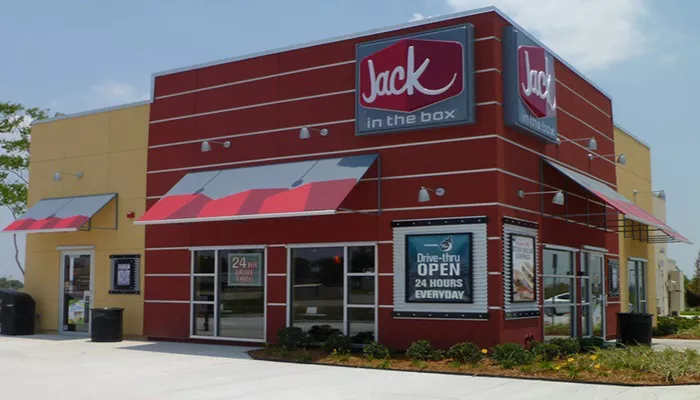Jack in the Box is a prominent name in the American fast-food landscape, known for its eclectic menu and innovative service model. Founded in 1951 by Robert O. Peterson in San Diego, California, the chain has become synonymous with quick service and a diverse range of food options. With over 2,200 locations primarily concentrated on the West Coast, Jack in the Box has carved out a unique niche in the fast-food industry. It is particularly recognized for its hamburgers, tacos, and breakfast offerings, making it a go-to choice for many consumers seeking variety and convenience.
The brand’s journey has been marked by both triumphs and challenges, including a pioneering role in introducing drive-thru service and a notable recovery from a major food safety crisis in the 1990s. This article delves into what makes Jack in the Box famous, exploring its history, signature menu items, marketing strategies, and cultural impact.
History of Jack in The Box
Early Beginnings
Jack in the Box was established as a drive-thru restaurant concept, which was revolutionary at the time. Peterson’s vision included a two-way intercom system that allowed customers to place orders without leaving their vehicles. This innovation not only enhanced customer convenience but also set a standard for future fast-food chains.
In its early years, Jack in the Box focused heavily on hamburgers. The first menu featured items such as burgers priced at an astonishing 18 cents. The brand quickly gained popularity due to its efficient service model and unique branding, which included a giant clown head atop each restaurant.
Expansion and Menu Diversification
By the 1960s, Jack in the Box had expanded significantly beyond California. The company was acquired by Ralston Purina in 1968, which further fueled its growth. During this period, Jack in the Box began to diversify its menu to include items like tacos and egg rolls—dishes that were not commonly found at other fast-food chains.
The introduction of breakfast items in 1969 marked another milestone for Jack in the Box. The chain became one of the first to offer breakfast sandwiches, catering to customers looking for convenient meal options throughout the day.
Signature Menu Items
Hamburgers
While Jack in the Box is well-known for its diverse menu offerings, it remains best recognized for its hamburgers. Signature items include:
Jumbo Jack®: A classic burger featuring a beef patty topped with lettuce, tomato, mayonnaise, and pickles.
Ultimate Cheeseburger: This burger boasts two beef patties and multiple layers of cheese, making it a favorite among cheese lovers.
Buttery Jack™: Known for its rich flavor profile due to a buttery spread on the bun.
Tacos
Perhaps one of the most surprising yet popular items on the menu is the taco. Jack in the Box tacos are unique because they are manufactured off-site, frozen, and then deep-fried at each location before being served with lettuce and cheese. The chain sells approximately 554 million tacos annually, making them one of its best-selling items since their introduction.
Breakfast Offerings
Jack in the Box has also made significant strides in breakfast offerings. The chain introduced breakfast burritos and sandwiches early on and continues to serve these items all day long. Popular breakfast choices include:
Breakfast Jack®: A sandwich featuring egg, cheese, and ham or bacon on a bun.
Bacon & Egg Chicken Sandwich: A newer addition that combines chicken with traditional breakfast flavors.
Unique Items
In addition to traditional fast-food fare, Jack in the Box has ventured into more unconventional territory with items like egg rolls and teriyaki bowls. This willingness to experiment sets it apart from competitors who often stick to more standard menus.
Marketing Strategies
Iconic Mascot
Jack in the Box’s mascot—Jack—has played a significant role in shaping the brand’s identity. Introduced as a clown with a distinctive round head and jester hat, Jack has been featured prominently in advertising campaigns since 1995. His character is often portrayed as quirky and humorous, appealing to a broad audience.
Innovative Advertising Campaigns
The “Jack’s Back” campaign is one of the longest-running advertising strategies in fast food history. It has helped maintain brand visibility while also allowing for playful engagement with consumers through various media formats.
Cultural Impact
Fast Food Culture
Jack in the Box has significantly influenced American fast food culture by introducing concepts that have become industry standards. Its pioneering of drive-thru service paved the way for countless other chains to adopt similar models.
Controversies
The brand has faced challenges that have shaped public perception over time. Notably, an E. coli outbreak linked to several locations in 1993 resulted in severe illness for many customers and prompted widespread media coverage. The incident led to significant changes within the company regarding food safety protocols and marketing strategies.
Despite these setbacks, Jack in the Box managed to recover through stringent safety measures and effective marketing campaigns that focused on quality assurance.
Conclusion
Jack in the Box stands out as one of America’s most versatile fast-food chains due to its diverse menu offerings that cater to various tastes and preferences. From its iconic hamburgers and unique tacos to innovative breakfast items available all day long, it provides customers with numerous choices that reflect changing dining habits.
Related topics:
- The 6 Best Items on Burger King Menu
- Is Burger King Is Halal?
- Where Is The Original Roscoe’s Chicken And Waffles

